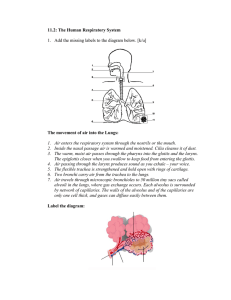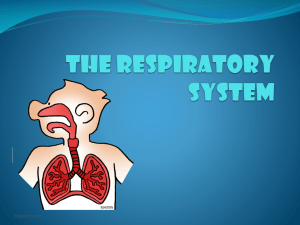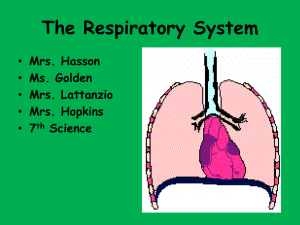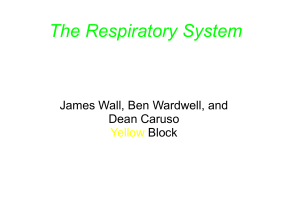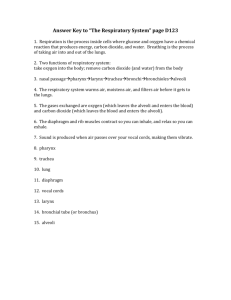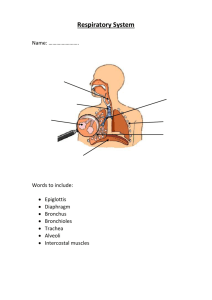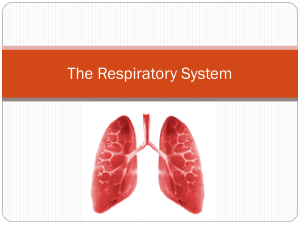respiratory system
advertisement
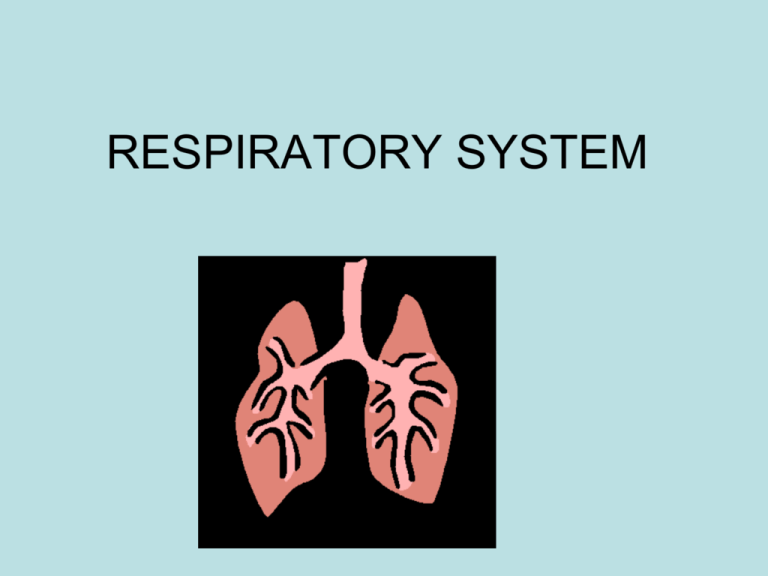
RESPIRATORY SYSTEM Main function? • To ensure that O2 is brought into the body and ready for cellular use all the time (cellular respiration in mitochondria) sugar + O2 energy + water + CO2 • To ensure that CO2 can leave each cell and is removed from the body (we can’t store it) In order for gas exchange to occur, several requirements are essential: 1) a tube to connect internal/external environments 2) muscles to bring the air in contact with the exchange surface 3) a moist surface where gas exchange occurs through diffusion Human Respiratory System • air enters the body through nostrils then nasal passages (also through mouth during exercise) • passes through the pharynx (throat) to the opening of the trachea (windpipe – made of c-shaped cartilage rings to keep it open) • Passes over the epiglottis, through the larynx (voice box) • travels down the trachea (made of cartilage rings to keep it open) • Then air goes down the trachea (10-12 cm long), then into two tubes (the lower respiratory tract) • from the trachea, air passes into the right and left bronchus, which enter the right and left lung. • Each lung is divided into lobes. The right lung has three lobes and the left lung has two. • Inside the lungs, each bronchus divides into a network of bronchioles. • Each bronchiole ends in a grape-like cluster of tiny sacs called alveoli (singular – alveolus). • alveoli walls are very thin, single-celled, and surrounded by capillaries Point of interaction between the respiratory and circulatory systems – this is where gas exchange happens • After inhalation, the concentration of O2 in the alveoli is higher than in blood in the capillaries next to the lungs • Therefore O2 diffuses out of alveoli into capillaries. • CO2 is higher in the capillaries than in the alveoli, so it diffuses into the alveoli to be exhaled The mechanics of breathing The brain controls it all – breathing movements, breathing rate, air volume, gas levels in blood, etc. What causes air to move in and out of lungs? Changes in air pressure – controlled by the diaphragm and rib (intercostal) muscles Inhalation • Rib muscles contract and diaphragm moves down • This expands the rib cage upward and outward, floor of chest cavity moves down • volume of lungs increases (they expand) therefore air comes in (pressure inside lungs is lower than pressure outside lungs, air moves along the concentration gradient) Exhalation • Begins when diaphragm and rib muscles relax – reduces volume of chest cavity • ribs move in and diaphragm moves up • volume of lungs decreases (higher pressure) , and air is forced out (lower pressure outside)

